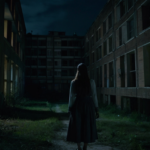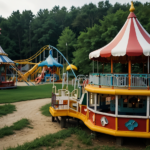
Eastern State Penitentiary, a monolithic structure of gothic grandeur and grim purpose, stands as a haunting testament to a bygone era of penal philosophy. Located in the heart of Philadelphia, Pennsylvania, this abandoned prison, now a National Historic Landmark, casts a long shadow, not just across the city’s landscape, but also across the annals of American criminal justice. Its imposing architecture, designed to instill both awe and dread, coupled with its notorious history of strict solitary confinement, has cemented its reputation as one of the most chilling and allegedly haunted locations in the United States.
The story of Eastern State begins in the early 19th century, a time of profound societal reform and evolving perspectives on crime and punishment. The “Pennsylvania System,” pioneered at Eastern State, was a radical departure from the prevailing practices of the day. It advocated for complete isolation and silence as a means of penitence and rehabilitation. The architects of this system believed that by isolating inmates from all human contact, they would be forced to confront their transgressions and seek redemption through introspection and divine contemplation.
The physical design of the penitentiary reflected this philosophy. Its fortress-like exterior, with towering stone walls and guard towers, conveyed a sense of impregnability. Inside, the cellblocks radiated outwards from a central rotunda, like spokes on a wheel, allowing for constant surveillance. Each cell was a self-contained unit, equipped with a small skylight, a wooden bed, a flush toilet, and a Bible. A small exercise yard, accessible only through a narrow door, provided a limited opportunity for fresh air and sunlight.
The inmates were subjected to a regime of unrelenting solitude. They were hooded whenever they left their cells, ensuring they never saw or were seen by another human being. They were forbidden from speaking, writing, or communicating in any way. The silence was absolute, broken only by the occasional clang of a cell door or the shuffling footsteps of a guard. This enforced isolation, intended to foster repentance, often led to profound psychological distress and, in some cases, outright madness.
The long-term effects of this system were devastating. Many inmates suffered from severe depression, anxiety, and hallucinations. Some became so disoriented that they lost all sense of time and place. The lack of human interaction, the sensory deprivation, and the constant fear of unseen eyes took a heavy toll on their mental and emotional well-being. Reports from the time document cases of inmates driven to self-harm, desperate for any form of sensation or release from the oppressive silence.
The experiment in solitary confinement, despite its noble intentions, ultimately proved to be a failure. By the late 19th century, the Pennsylvania System was gradually abandoned in favor of more conventional prison models. However, the legacy of Eastern State’s early years continued to haunt its walls.
Even after the strict solitary system was discontinued, Eastern State remained a formidable and often brutal institution. Over the years, it housed some of the most notorious criminals of the era, including Al Capone, who spent eight months in a luxurious cell, specially furnished to accommodate his status. Stories of inmate mistreatment, violence, and even death continued to circulate, adding to the prison’s dark mystique.
Eastern State Penitentiary officially closed its doors in 1971. After years of abandonment and decay, the prison was transformed into a historic site and museum. Today, visitors can explore the crumbling cellblocks, the echoing corridors, and the overgrown exercise yards, experiencing firsthand the chilling atmosphere that once permeated the penitentiary.
However, it’s not just the history and architecture that draws visitors to Eastern State. The prison has also gained a reputation as one of the most haunted locations in the United States. Reports of paranormal activity are rampant, with visitors and staff alike claiming to have witnessed ghostly apparitions, heard disembodied voices, and experienced unexplained phenomena.
Some of the most frequently reported phenomena include:
- The Cellblock 12 Shadow: This area is known for intense cold spots and shadow figures. Many people have reported seeing a dark, shadowy figure moving through the cells, often accompanied by a feeling of unease.
- The Disembodied Voices: Visitors have reported hearing whispers, murmurs, and even screams emanating from empty cells. These sounds are often described as being faint and distorted, as if they are echoes from the past.
- The Guard Towers: The guard towers, once used to monitor the inmates, are said to be haunted by the spirits of former guards. Visitors have reported feeling watched or followed while near the towers, and some have even claimed to see ghostly figures peering down at them.
- Al Capone’s Cell: Even the notorious Al Capone’s cell is said to hold paranormal acitivity. Some people have reported hearing his voice.
These accounts, coupled with the prison’s history of suffering and despair, have fueled the belief that Eastern State is a place where the spirits of the past still linger. The combination of historical fact and alleged paranormal activity creates a truly unique and unsettling experience for visitors.
The architectural features of the prison intensify this feeling. The high stone walls, the narrow corridors, and the dimly lit cells create a sense of claustrophobia and isolation. The overgrown vegetation and the crumbling infrastructure add to the sense of decay and abandonment. The overall effect is one of eerie beauty and profound sadness.
Eastern State Penitentiary serves as a poignant reminder of the darker aspects of human nature. It’s a place where the ideals of reform and rehabilitation collided with the harsh realities of punishment and confinement. It’s a place where the human spirit was tested to its limits, and where, according to many, the echoes of those tests still resonate.
Visiting Eastern State is more than just a historical tour. It’s an immersive experience that engages the senses and challenges the imagination. It’s a chance to confront the ghosts of the past, both literal and metaphorical. And it’s a reminder that even in the most imposing and seemingly impenetrable structures, the human spirit, in its strength and its fragility, leaves an indelible mark.
It is important to remember that much of the paranormal activity that is reported is anecdotal. Yet, the sheer volume of stories, and the consistancy of those stories, gives many people pause. Combined with the documented historical tragedies that occured in that place, it is easy to see why so many people feel that it is a location that holds on to a disturbing past.
In conclusion, Eastern State Penitentiary stands as a powerful symbol of a bygone era of penal philosophy. Its architectural grandeur, its dark history, and its reputation for paranormal activity make it a truly unique and haunting destination. Whether you believe in ghosts or not, a visit to Eastern State is sure to leave a lasting impression.

















































